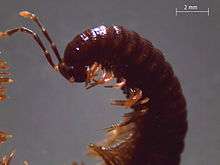Schizopetalidae
Schizopetalidae is a family of crested millipedes in the order Callipodida. There are more than 10 genera in Schizopetalidae.[1][2][3][4]
| Schizopetalidae | |
|---|---|
 | |
| Apfelbeckia insculpta | |
| Scientific classification | |
| Kingdom: | Animalia |
| Phylum: | Arthropoda |
| Class: | Diplopoda |
| Order: | Callipodida |
| Family: | Schizopetalidae Verhoeff, 1909 |
The Schizopetalidae subfamily Tynommatinae was recently elevated in rank to family (Tynommatidae), which resulted in the transfer of these 12 genera to the new family: Aspidiophon, Caliactis, Colactis, Colactoides, Diactis, Etiron, Florea, Heptium, Idrionaria, Mexicopetalum, Texophon, and Tynomma.[5]
Genera
- Acanthopetalum Verhoeff, 1900
- Apfelbeckia Verhoeff, 1896
- Balkanopetalum Verhoeff, 1926
- Callipodella Verhoeff, 1900
- Dischizopetalum Verhoeff, 1900
- Eurygyrus Koch & C.L., 1847
- Euxinopetalum Hoffman, 1973
- Himatiopetalum Verhoeff, 1900
- Micropodella
- Prolysiopetalum Verhoeff, 1909
- Schizopetalum Verhoeff, 1900
gollark: <@486184390943178763> Yes but it would be temporary, you see.
gollark: Another good idea I heard was one new prize type every year, with old ones being retired to the market cheaply.
gollark: I could use that as a name for a dragon! This is the great thing about flexible naming schemes.
gollark: Ooh, "ouroboros of prize arguments", that's a good phrase.
gollark: I'd like them to be something like NDs, where you can make them and there's some randomness but also skill.
References
- "Schizopetalidae Report". Integrated Taxonomic Information System. Retrieved 2019-02-18.
- "Schizopetalidae". GBIF. Retrieved 2019-02-18.
- "Schizopetalidae Family Information". bugguide.net. Retrieved 2019-02-18.
- Shelley, R.M. "The myriapods, the world's leggiest animals". Retrieved 2019-02-18.
- Shelley, Rowland M.; Richart, Casey (2014). "Tynommatidae, n. stat., a family American millipeds: Hypotheses affinities; tribal elevations; rediagnoses Loomis, 1937, and Florea and Caliactis, Shelley, 1996; and description of (Callipodida: Schizopetalidea)". Insecta Mundi. 845.
Further reading
- Brewer, M.S.; Sierwald, P.; Bond, J.E. (2012). "Millipede Taxonomy after 250 Years: Classification and Taxonomic Practices in a Mega-Diverse yet Understudied Arthropod Group". PLOS One. 7 (5): e37240. Bibcode:2012PLoSO...737240B. doi:10.1371/journal.pone.0037240. ISSN 1932-6203. PMC 3352885. PMID 22615951.
- Golovatch, Sergei I.; Kime, R.Desmond (2009). "Millipede (Diplopoda) distributions: A review" (PDF). Soil Organisms. 81: 565–597.
- Hoffman, Richard L. (1999). Checklist of the millipeds of North and Middle America. Virginia Museum of Natural History Special Publications. ISBN 9781884549120.
- Minelli, Alessandro, ed. (2015). Treatise on Zoology - Anatomy, Taxonomy, Biology. The Myriapoda, Volume 2. Brill. ISBN 978-9004156128.
- Sierwald, Petra; Bond, Jason E. (2007). "Current status of the myriapod class Diplopoda (millipedes): taxonomic diversity and phylogeny". Annual Review of Entomology. 52: 401–420. doi:10.1146/annurev.ento.52.111805.090210. PMID 17163800.
This article is issued from Wikipedia. The text is licensed under Creative Commons - Attribution - Sharealike. Additional terms may apply for the media files.